| Listing 1 - 10 of 47 | << page >> |
Sort by
|
Book
ISSN: 00725285 ISBN: 1461411351 Year: 2011 Volume: 262 Publisher: New York, NY : Springer New York : Imprint: Springer,
Abstract | Keywords | Export | Availability | Bookmark
 Loading...
Loading...Choose an application
- Reference Manager
- EndNote
- RefWorks (Direct export to RefWorks)
Essentials of Integration Theory for Analysis is a substantial revision of the best-selling Birkhäuser title by the same author, A Concise Introduction to the Theory of Integration. Highlights of this new textbook for the GTM series include revisions to Chapter 1 which add a section about the rate of convergence of Riemann sums and introduces a discussion of the Euler–MacLauren formula. In Chapter 2, where Lebesque’s theory is introduced, a construction of the countably additive measure is done with sufficient generality to cover both Lebesque and Bernoulli measures. Chapter 3 includes a proof of Lebesque’s differential theorem for all monotone functions and the concluding chapter has been expanded to include a proof of Carathéory’s method for constructing measures and his result is applied to the construction of the Hausdorff measures. This new gem is appropriate as a text for a one-semester graduate course in integration theory and is complimented by the addition of several problems related to the new material. The text is also highly useful for self-study. A complete solutions manual is available for instructors who adopt the text for their courses. Additional publications by Daniel W. Stroock: An Introduction to Markov Processes, ©2005 Springer (GTM 230), ISBN: 978-3-540-23499-9; A Concise Introduction to the Theory of Integration, © 1998 Birkhäuser Boston, ISBN: 978-0-8176-4073-6; (with S.R.S. Varadhan) Multidimensional Diffusion Processes, © 1979 Springer (Classics in Mathematics), ISBN: 978-3-540-28998-2.
Mathematical analysis. --- 517.1 Mathematical analysis --- Mathematical analysis --- Global analysis (Mathematics). --- Mathematics. --- Analysis. --- Real Functions. --- Math --- Science --- Analysis, Global (Mathematics) --- Differential topology --- Functions of complex variables --- Geometry, Algebraic --- Fourier analysis. --- Integrals, Generalized. --- Integration, Functional. --- Measure theory. --- Analysis (Mathematics). --- Functions of real variables. --- Real variables
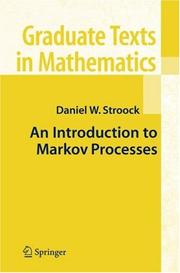
ISBN: 3540269908 3540234993 3540234519 9787510004483 9783540234999 7510004489 9783540234517 Year: 2005 Publisher: Berlin Springer
Abstract | Keywords | Export | Availability | Bookmark
 Loading...
Loading...Choose an application
- Reference Manager
- EndNote
- RefWorks (Direct export to RefWorks)
To some extent, it would be accurate to summarize the contents of this book as an intolerably protracted description of what happens when either one raises a transition probability matrix P (i. e. , all entries (P)»j are n- negative and each row of P sums to 1) to higher and higher powers or one exponentiates R(P — I), where R is a diagonal matrix with non-negative entries. Indeed, when it comes right down to it, that is all that is done in this book. However, I, and others of my ilk, would take offense at such a dismissive characterization of the theory of Markov chains and processes with values in a countable state space, and a primary goal of mine in writing this book was to convince its readers that our offense would be warranted. The reason why I, and others of my persuasion, refuse to consider the theory here as no more than a subset of matrix theory is that to do so is to ignore the pervasive role that probability plays throughout. Namely, probability theory provides a model which both motivates and provides a context for what we are doing with these matrices. To wit, even the term "transition probability matrix" lends meaning to an otherwise rather peculiar set of hypotheses to make about a matrix.
Markov processes. --- Stochastic processes. --- Random processes --- Probabilities --- Analysis, Markov --- Chains, Markov --- Markoff processes --- Markov analysis --- Markov chains --- Markov models --- Models, Markov --- Processes, Markov --- Stochastic processes --- Distribution (Probability theory. --- Probability Theory and Stochastic Processes. --- Distribution functions --- Frequency distribution --- Characteristic functions --- Probabilities. --- Probability --- Statistical inference --- Combinations --- Mathematics --- Chance --- Least squares --- Mathematical statistics --- Risk
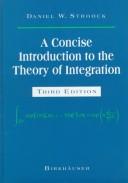
ISBN: 0817640738 3764340738 9780817640736 Year: 1999 Publisher: Boston, Mass. Birkhäuser
Abstract | Keywords | Export | Availability | Bookmark
 Loading...
Loading...Choose an application
- Reference Manager
- EndNote
- RefWorks (Direct export to RefWorks)
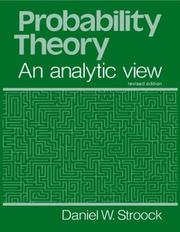
ISBN: 0521431239 9780521431231 Year: 1993 Publisher: Cambridge Cambridge University Press
Abstract | Keywords | Export | Availability | Bookmark
 Loading...
Loading...Choose an application
- Reference Manager
- EndNote
- RefWorks (Direct export to RefWorks)
Stochastic processes --- Probabilities --- Probabilités --- 519.2 --- Probability --- Statistical inference --- Combinations --- Mathematics --- Chance --- Least squares --- Mathematical statistics --- Risk --- Probability. Mathematical statistics --- Probabilities. --- 519.2 Probability. Mathematical statistics --- Probabilités
Book
ISBN: 0817637591 1475723024 1475723008 9780817637590 Year: 1994 Publisher: Boston, Mass. Birkhäuser
Abstract | Keywords | Export | Availability | Bookmark
 Loading...
Loading...Choose an application
- Reference Manager
- EndNote
- RefWorks (Direct export to RefWorks)
Measure theory. Mathematical integration --- Integrals, Generalized. --- Measure theory. --- Integrals, Generalized --- Measure theory --- 517.2 --- 517.2 Differential calculus. Differentiation --- Differential calculus. Differentiation --- Lebesgue measure --- Measurable sets --- Measure of a set --- Algebraic topology --- Measure algebras --- Rings (Algebra) --- Calculus, Integral
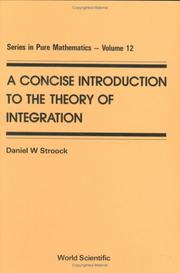
ISBN: 9810201451 Year: 1990 Volume: vol 12 Publisher: Singapore London Hong Kong World Scientific
Abstract | Keywords | Export | Availability | Bookmark
 Loading...
Loading...Choose an application
- Reference Manager
- EndNote
- RefWorks (Direct export to RefWorks)
Integralen [Veralgemeende ] --- Integrales generalisees --- Integrals [Generalized ] --- Measure theory --- Mesure [Théorie de la ] --- Metingen--Theorie --- Integrals, Generalized --- Intégrales généralisées --- Mesure, Théorie de la --- 517.2 --- Lebesgue measure --- Measurable sets --- Measure of a set --- Algebraic topology --- Measure algebras --- Rings (Algebra) --- Calculus, Integral --- Differential calculus. Differentiation --- 517.2 Differential calculus. Differentiation --- Intégrales généralisées --- Mesure, Théorie de la --- Integrals, Generalized. --- Measure theory.
Book
ISBN: 038796021X 1461385148 9780387960210 Year: 1984 Publisher: New York : Springer-Verlag,
Abstract | Keywords | Export | Availability | Bookmark
 Loading...
Loading...Choose an application
- Reference Manager
- EndNote
- RefWorks (Direct export to RefWorks)
Large deviations --- Grandes déviations --- Grandes déviations
Book
ISBN: 3642405223 3642405231 Year: 2014 Publisher: Berlin, Heidelberg : Springer Berlin Heidelberg : Imprint: Springer,
Abstract | Keywords | Export | Availability | Bookmark
 Loading...
Loading...Choose an application
- Reference Manager
- EndNote
- RefWorks (Direct export to RefWorks)
This book provides a rigorous but elementary introduction to the theory of Markov Processes on a countable state space. It should be accessible to students with a solid undergraduate background in mathematics, including students from engineering, economics, physics, and biology. Topics covered are: Doeblin's theory, general ergodic properties, and continuous time processes. Applications are dispersed throughout the book. In addition, a whole chapter is devoted to reversible processes and the use of their associated Dirichlet forms to estimate the rate of convergence to equilibrium. These results are then applied to the analysis of the Metropolis (a.k.a simulated annealing) algorithm. The corrected and enlarged 2nd edition contains a new chapter in which the author develops computational methods for Markov chains on a finite state space. Most intriguing is the section with a new technique for computing stationary measures, which is applied to derivations of Wilson's algorithm and Kirchoff's formula for spanning trees in a connected graph.
Distribution (Probability theory) --- Markov processes. --- Markov, Processus de. --- Markov-processen. --- Processos de markov. --- Markov-Prozess. --- Mathematics. --- Differentiable dynamical systems. --- Mathematics --- Physical Sciences & Mathematics --- Mathematical Statistics --- Analysis, Markov --- Chains, Markov --- Markoff processes --- Markov analysis --- Markov chains --- Markov models --- Models, Markov --- Processes, Markov --- Distribution functions --- Frequency distribution --- Differential dynamical systems --- Dynamical systems, Differentiable --- Dynamics, Differentiable --- Math --- Dynamics. --- Ergodic theory. --- Probabilities. --- Probability Theory and Stochastic Processes. --- Dynamical Systems and Ergodic Theory. --- Characteristic functions --- Probabilities --- Differential equations --- Global analysis (Mathematics) --- Topological dynamics --- Distribution (Probability theory. --- Ergodic transformations --- Continuous groups --- Mathematical physics --- Measure theory --- Transformations (Mathematics) --- Dynamical systems --- Kinetics --- Mechanics, Analytic --- Force and energy --- Mechanics --- Physics --- Statics --- Probability --- Statistical inference --- Combinations --- Chance --- Least squares --- Mathematical statistics --- Risk
Book
ISBN: 3319244671 3319244698 Year: 2015 Publisher: Cham : Springer International Publishing : Imprint: Springer,
Abstract | Keywords | Export | Availability | Bookmark
 Loading...
Loading...Choose an application
- Reference Manager
- EndNote
- RefWorks (Direct export to RefWorks)
This book provides an introduction to the basic ideas and tools used in mathematical analysis. It is a hybrid cross between an advanced calculus and a more advanced analysis text and covers topics in both real and complex variables. Considerable space is given to developing Riemann integration theory in higher dimensions, including a rigorous treatment of Fubini's theorem, polar coordinates and the divergence theorem. These are used in the final chapter to derive Cauchy's formula, which is then applied to prove some of the basic properties of analytic functions. Among the unusual features of this book is the treatment of analytic function theory as an application of ideas and results in real analysis. For instance, Cauchy's integral formula for analytic functions is derived as an application of the divergence theorem. The last section of each chapter is devoted to exercises that should be viewed as an integral part of the text. A Concise Introduction to Analysis should appeal to upper level undergraduate mathematics students, graduate students in fields where mathematics is used, as well as to those wishing to supplement their mathematical education on their own. Wherever possible, an attempt has been made to give interesting examples that demonstrate how the ideas are used and why it is important to have a rigorous grasp of them.
Algebra --- Mathematics --- Physical Sciences & Mathematics --- Mathematics. --- Functional analysis. --- Functions of complex variables. --- Integral equations. --- Functions of real variables. --- Sequences (Mathematics). --- Functional Analysis. --- Real Functions. --- Functions of a Complex Variable. --- Sequences, Series, Summability. --- Integral Equations. --- Mathematical sequences --- Numerical sequences --- Equations, Integral --- Functional equations --- Functional analysis --- Complex variables --- Elliptic functions --- Functions of real variables --- Functional calculus --- Calculus of variations --- Integral equations --- Math --- Science --- Associative rings. --- Rings (Algebra) --- Mathematical analysis. --- Algebraic rings --- Ring theory --- Algebraic fields --- 517.1 Mathematical analysis --- Mathematical analysis --- Real variables --- Functions of complex variables
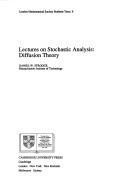
ISBN: 0521336457 0521333660 9780521336451 9780521333665 Year: 1987 Volume: 6 Publisher: Cambridge Cambridge UP
Abstract | Keywords | Export | Availability | Bookmark
 Loading...
Loading...Choose an application
- Reference Manager
- EndNote
- RefWorks (Direct export to RefWorks)
Stochastic processes --- 519.217 --- 519.217 Markov processes --- Markov processes --- Diffusion processes
| Listing 1 - 10 of 47 | << page >> |
Sort by
|

 Search
Search Feedback
Feedback About UniCat
About UniCat  Help
Help News
News